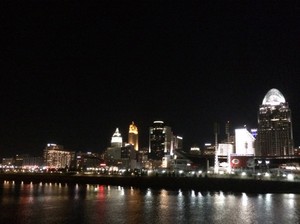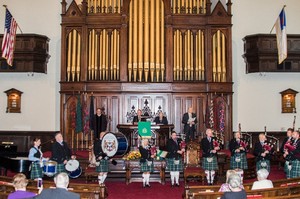Two Cincinnati Presbyterian Church (U.S.A.) congregations celebrated 225 years of ministry this past weekend. Founded Oct. 16, 1790, First Presbyterian Church began as a two-site church plant, meeting in the Fort Washington and Duck Creek areas, and ultimately became Covenant-First and Pleasant Ridge churches. The congregations marked the occasion with special worship services, community recognition, the commissioning of an anniversary anthem and dedication to continued ministry.
European Americans settled Cincinnati in 1788, and Presbyterian missionaries came to the shores of the Ohio River shortly thereafter to assume the work of building spiritual communities. First Presbyterian Church organized itself only weeks before the establishment of the Presbytery of Cincinnati in November 1790, cementing the Presbyterian presence in the city. It is said that the first pastor of the two-site church, the Rev. James Kemper, rode his horse between Sunday services at the congregations with a musket on his saddle to discourage ruffians from attacking him in the riverside boom-town.
Cincinnati experienced a time of explosive growth as a major shipping center in the Midwest in the early 1800s. First Presbyterian expanded too, spawning many church plants as the city grew along the river and to the north. Covenant-First Church, the combination of Covenant Presbyterian with the original First Church in the 1930s, now occupies its fourth building in the city and is a prominent architectural landmark in downtown Cincinnati.
Pleasant Ridge Church is at its third location since its founding, the first two sites having succumbed to high water, and sits on a flood-resistant ridge in the east-central section of the Cincinnati metro area.
Covenant-First is, in fact, observing three anniversaries this year. In addition to the church’s founding, it celebrated the 140th anniversary of its current building, dedicated April 11, 1875. And November 15 is the 100th anniversary of the dedication of the church’s historic Austin pipe organ.
Each church marked the anniversary with a full weekend of festivities.
Covenant-First Presbyterian held a Thanksgiving-style dinner Friday with a program recalling the past 225 years and offering "spiritual reflections" from its pastor, the Rev. Russell Smith. Sunday’s worship featured the Cincinnati Caledonian Pipes & Drums Band, recognition of long-term members and guest preacher, the Rev. Dr. David Fisher. Cincinnati General Presbyter, the Rev. James DiEgidio, joined Covenant-First on Friday night and Sunday morning. The congregation took a special mission offering to support City Gospel Mission, Llanfair Retirement Community and the Rev. Michael and Rachel Ludwig, PC(USA) mission co-workers in Niger.

Cincinnati's skyline as seen from the Belle of Cincinnati on the Ohio River during the Pleasant Ridge 225th anniversary cruise. —K. Nicholas Yoda
Pleasant Ridge Presbyterian offered members a dinner cruise on the Belle of Cincinnati Saturday evening and invited past clergy to participate in the Sunday anniversary service and luncheon. The church also marked the anniversary with the commissioning of a new anthem—“Now Joyful Voices Rise” by Chicago composer Paul Carey—performed at the service.
Honoring the connection the two churches share, the Rev. Dr. K. Nicholas Yoda, pastor at Pleasant Ridge, attended Covenant-First’s Friday evening dinner, and Smith was present on Pleasant Ridge’s riverboat cruise Saturday.
Both churches honored vital links to the community in the anniversary celebration. Mayor John Cranley issued a proclamation declaring Friday, Oct. 16, 2015, Covenant-First Presbyterian Church Day in the City of Cincinnati, and vice-mayor David Mann was on hand at Sunday’s service to deliver greetings.
Pleasant Ridge’s theme for the anniversary is “Rooted in Community—Growing the Future,” and Yoda says the church is exploring ways a major gift, made on behalf of the congregation, can leave a lasting mark in the community.
“We’ve just dedicated what is called Heritage Hall, the main framework of our building update,” says Yoda of a recent renovation and capital campaign to modernize its facilities. “We feel this is a fulcrum for our future. And that future [depends] not only, by the grace of God, on a structure, but on a sense of call as a congregation and a strong sense of presence in our community.”
A long-running joke between the two churches disputes which congregation is the oldest in Cincinnati. While Covenant-First proclaims itself “the oldest Presbyterian congregation west of the Allegheny Mountains,” Yoda says, with a chuckle, “we still say we’re the oldest.”
“In fact,” laughs Smith in response, “there’s no dispute. We were founded the same day. What is unique is that long before megachurches and satellite feeds, we were a multi-site congregation—preceding the current big campus churches by 200 years.”
As for the nature of being a big steeple downtown church, Smith believes historic churches still play a vital role in inviting people to experience faith.
“Some people would walk in and say ‘this is a stuffy old church,’” he says. “But, we’re fixing our eyes on Jesus, the author and perfecter of our faith. I’m not really the typical ‘Old First’ pastor that’s really concerned with being the dignified city pastor or church; any church worth their salt is pursuing [Jesus.] There are people coming into our doors to meet Christ who would never go to a big-box megachurch. We still have a vital ministry.”
“Cincinnati is a city going through transition,” says Smith. “There’s a renaissance going on in downtown Cincinnati. The city is becoming known as a hub of design, culture and food. We are constantly asking, ‘How do we connect with this exciting and vibrant community?’ We’re excited about the future.”
“Though we look back to appreciate the shoulders that we stand upon, we are definitely not going back,” Yoda said in an interview before the weekend events. “We’re going to have a good time, but we’re also going to wake up Monday morning and get busy being the church.”
“I think of institutions as a conversation across generations,” says Smith. “We have 225 years of heritage, but we also want to be in conversation with future generations. It’s not just an exercise in looking back, but also in looking forward, asking, ‘What is God calling us to in the next 225 years?’ Or at least the time we’ll have to be a part of it.”

